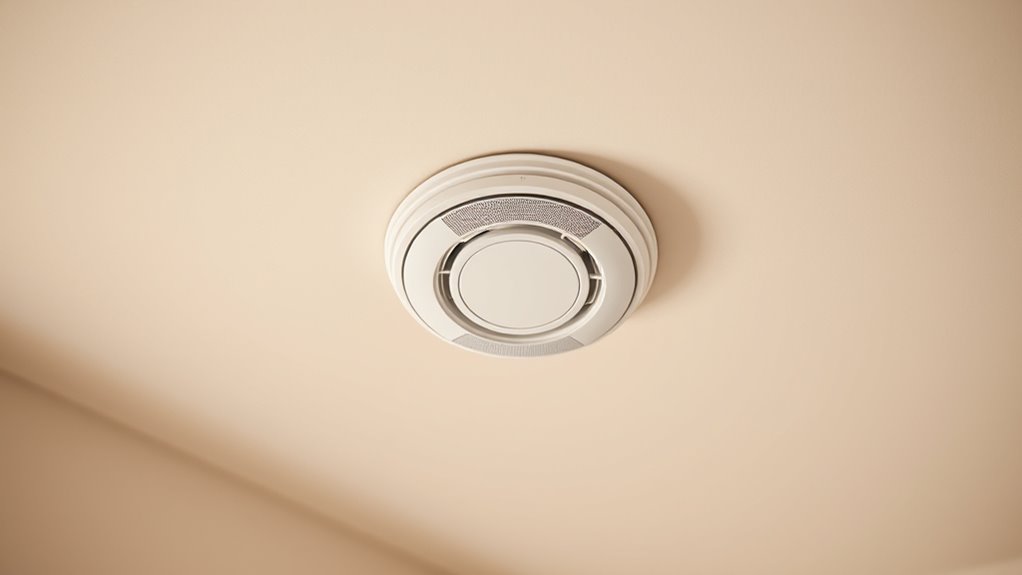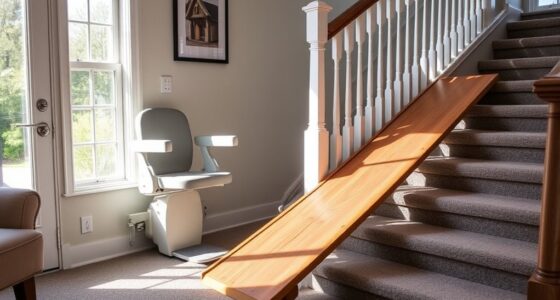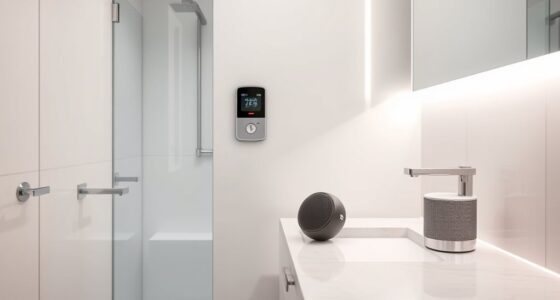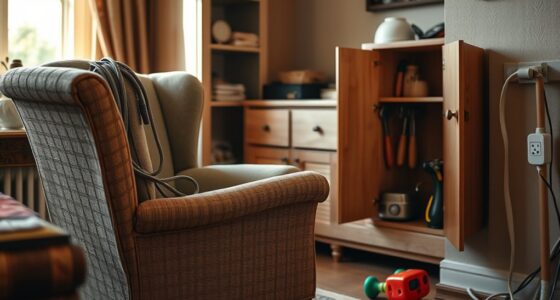To keep your home safe, install smoke alarms inside bedrooms, outside sleeping areas, and on every level, including basements, placing them at least 10 feet from kitchens and bathrooms to reduce false alarms. For carbon monoxide, put detectors on each level, especially near bedrooms and away from fuel-burning appliances. Avoid high humidity areas or dead air spots, and regularly test and maintain your alarms. Continue exploring to learn even more about ideal placement and safety tips.
Key Takeaways
- Install smoke alarms inside bedrooms, outside sleeping areas, and on every home level, including basements.
- Place carbon monoxide detectors on each level near bedrooms and living areas, at least 15 feet from fuel-burning appliances.
- Keep alarms at least 10 feet from kitchens and bathrooms to prevent false alarms.
- Use photoelectric smoke alarms for smoldering fires and ionization alarms for flaming fires.
- Regularly test alarms monthly, replace batteries annually, and keep detectors clean for optimal performance.
Ideal Locations for Smoke Alarms in Your Home

To guarantee maximum protection, you should install smoke alarms in the right locations throughout your home. Recognizing the fire risk in different areas helps determine where alarms are most effective. Install smoke alarms inside bedrooms, outside sleeping areas, and on every level of your home, including the basement. This ensures early detection regardless of where a fire starts. Consider the alarm types available—photoelectric alarms are excellent for detecting smoldering fires, while ionization alarms respond faster to flaming fires. Place alarms at least 10 feet from kitchens and bathrooms to reduce false alarms caused by cooking or steam. Proper placement maximizes safety, giving you ample warning to act swiftly if smoke or fire is detected.
Proper Placement of Carbon Monoxide Detectors
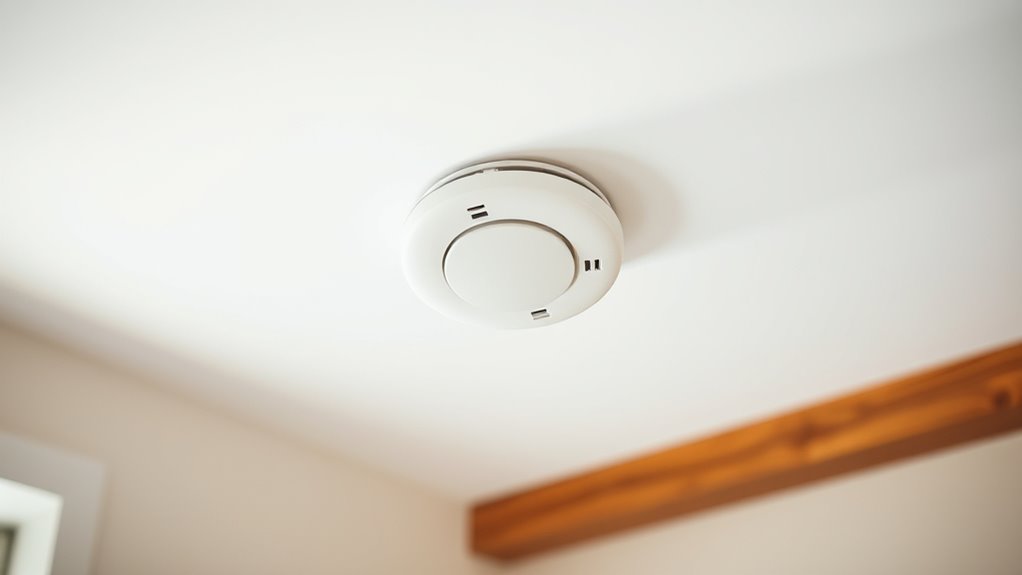
Since carbon monoxide (CO) is a colorless, odorless gas that can build up silently, placing detectors in the right locations is essential for your safety. Install CO detectors on every level of your home, especially near bedrooms and living areas, to guarantee you’re alerted promptly. Keep detectors at least 15 feet away from fuel-burning appliances to minimize false alarms. Regularly check the detector battery life to secure continuous protection, replacing batteries at least once a year. Opt for interconnected alarms, so when one detects CO, all activate simultaneously, providing broader coverage and faster warning. Avoid placing detectors in dead air spots, such as corners or closets, to maximize their effectiveness. Proper placement and maintenance are critical for reliable early detection. Additionally, choosing appropriate detector types that suit your home’s needs can enhance overall safety.
Common Mistakes to Avoid When Installing Safety Alarms
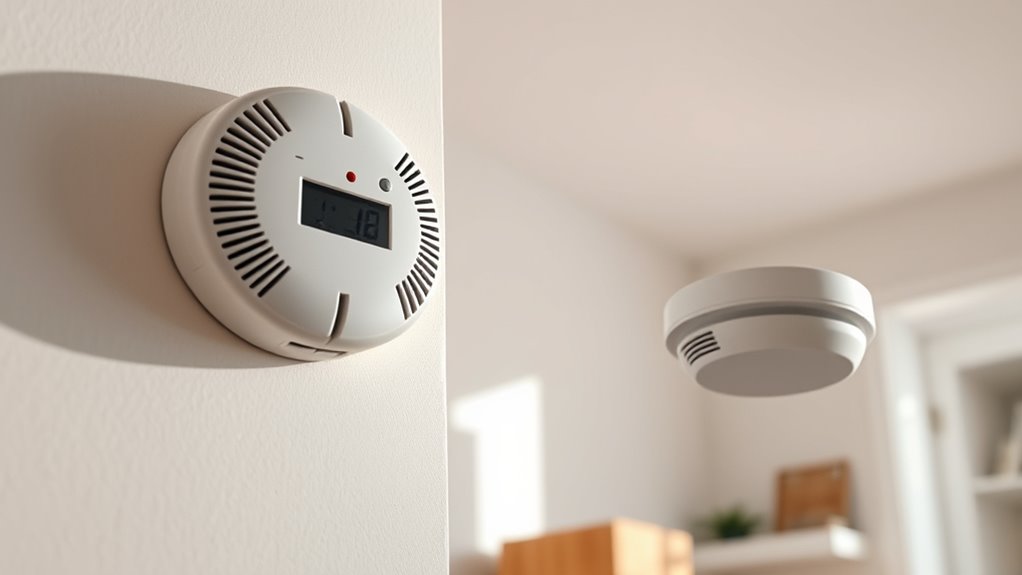
Installing safety alarms incorrectly can compromise your home’s protection and increase the risk of missing an emergency. One common mistake is neglecting to check alarm battery life regularly, which can cause alarms to fail unexpectedly. Always use fresh batteries and replace them according to the manufacturer’s guidelines. Another mistake is overlooking alarm interconnectivity; if alarms aren’t interconnected, one malfunctioning unit might not alert you to dangers in other parts of your home. Make sure your alarms are compatible and properly linked so that when one sounds, all activate. Avoid placing alarms in locations with high humidity, near vents, or too far from sleeping areas, as this can reduce their effectiveness. Proper placement and maintenance are essential for reliable safety alerts. Additionally, understanding the contrast ratio of your alarm system can help ensure it is visible and effective in various lighting conditions.
Tips for Maintaining and Testing Your Alarms

Regularly maintaining and testing your smoke and carbon monoxide alarms guarantees they function correctly when needed most. Start by testing each alarm monthly by pressing the test button until you hear the alarm sound. Replace batteries at least once a year or when the low-battery warning chirps, as battery lifespan varies. Keep alarms clean by gently vacuuming to remove dust and debris that can interfere with operation. Check alarm calibration periodically to ensure sensors remain accurate; if an alarm isn’t responding properly, replace it or recalibrate according to the manufacturer’s instructions. Remember, proper maintenance extends the life of your alarms and ensures they remain sensitive to danger signals. Consistent testing and upkeep are key to reliable early warning in emergencies. Incorporating expert voice actors into your alarm announcements can improve clarity and effectiveness, making sure everyone understands the importance of these safety measures.
Special Considerations for Different Rooms and Areas
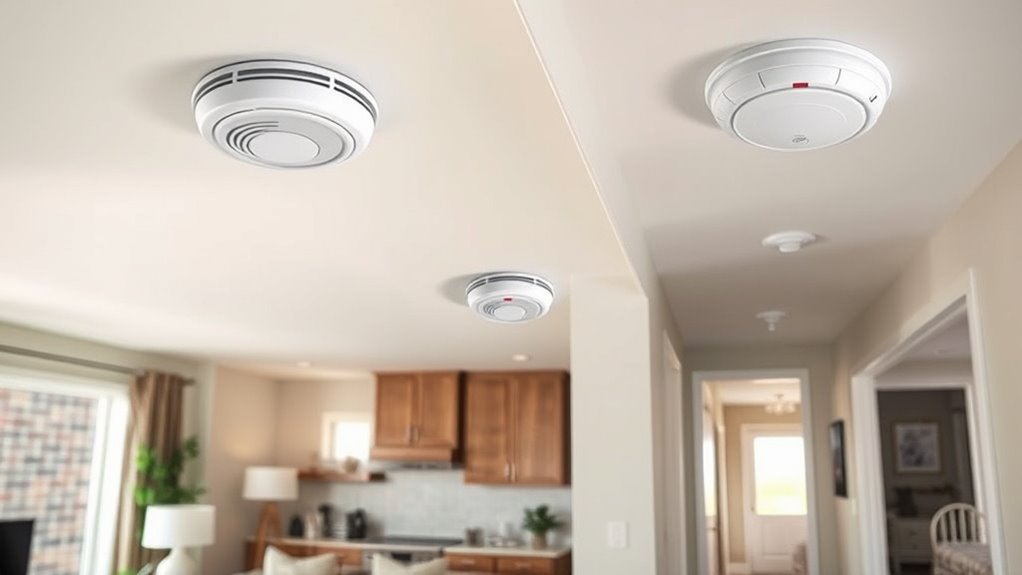
Different rooms and areas in your home require tailored placement and considerations for smoke and carbon monoxide alarms to maximize safety. In rooms with fire resistant materials, alarms may need to be placed closer to ensure detection isn’t delayed. In bedrooms, alarms should be installed outside sleeping areas to minimize sound emission levels that can disturb sleep but still alert you effectively. Kitchens pose a challenge due to cooking fumes, so alarms should be placed at a safe distance to prevent false alarms while maintaining safety. Basements and garages might require additional alarms, especially near fuel-burning appliances. Always consider the room’s layout and potential obstructions. Proper placement guarantees alarms are effective, reliable, and compliant with safety standards, providing peace of mind in every part of your home. Additionally, vetted smoke and carbon monoxide alarms are designed with advanced features like interconnected alerts and easy maintenance to enhance home safety.
Frequently Asked Questions
How Often Should I Replace Batteries in My Alarms?
You should replace the batteries in your alarms at least once a year, as the typical battery lifespan is about 12 months. To guarantee they work properly, consider changing them during a specific event, like daylight saving time. If your alarm starts chirping, it’s a sign the batteries need replacing sooner. Regular replacement frequency helps keep your alarms reliable and ensures you’re protected from smoke and carbon monoxide dangers.
Can Alarms Be Installed Outdoors or in Garages?
They say “better safe than sorry,” so you shouldn’t install alarms outdoors or in garages. These areas face weather exposure, which can harm the devices or cause false alarms. Instead, place alarms indoors where they’re protected but still alert you quickly to dangers. For garages, install alarms outside the space, near the door, to ensure you’re warned if smoke or carbon monoxide is present.
Are There Any Specific Brands Recommended for Reliability?
You should look for recommended brands and trusted manufacturers when choosing alarms. Brands like Kidde, First Alert, and Nest are well-known for reliability and safety features. These trusted manufacturers prioritize quality, ensuring their alarms meet safety standards. Investing in alarms from these recommended brands gives you peace of mind, knowing they are built to effectively detect hazards and provide early warnings, keeping your home and family safe.
What Should I Do if an Alarm Keeps False Triggering?
If your alarm keeps false triggering, don’t ignore it—act quickly. First, reset the alarm following the manufacturer’s instructions; this often stops false alarms. Then, check for common causes like dust, humidity, or insects that can trigger false alarms. To prevent future issues, verify proper alarm placement and regularly maintain your alarms. Addressing these issues promptly can keep your home safe without the stress of constant false alarms.
How Do I Interpret Different Alarm Signals or Tones?
You should listen carefully to the alarm sound patterns to interpret signals correctly. A steady beeping usually indicates low battery or malfunction, while rapid, repetitive beeps often mean carbon monoxide or smoke detection. If you hear different alarm signals, consult your alarm’s manual for specific interpretations. Always prioritize safety by acting promptly—evacuate if necessary—and contact emergency services to handle potential hazards. Understanding alarm signals helps you respond effectively in emergencies.
Conclusion
Think of your alarms as vigilant guardians watching over your home’s peace. Proper placement and maintenance are their armor, shielding you from unseen dangers like silent shadows and smoky whispers. When you respect their boundaries and test their senses, they stand ready—your unwavering protectors in the dark. Trust in their watchful presence, and let them be the lighthouse guiding you safely through every night, keeping your loved ones secure amidst life’s unpredictable storms.
